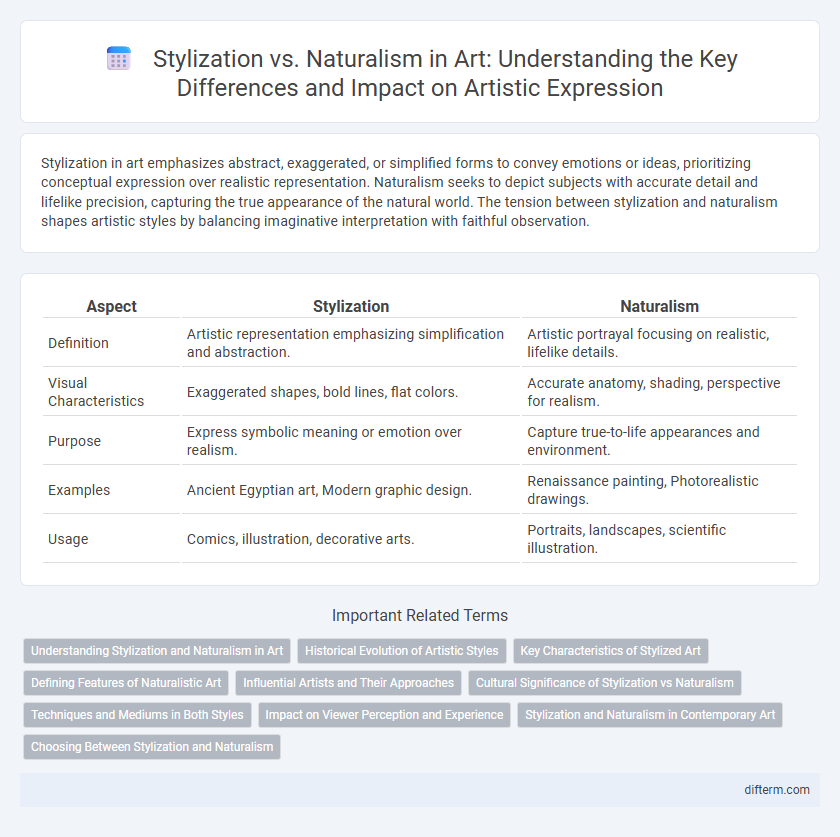Stylization in art emphasizes abstract, exaggerated, or simplified forms to convey emotions or ideas, prioritizing conceptual expression over realistic representation. Naturalism seeks to depict subjects with accurate detail and lifelike precision, capturing the true appearance of the natural world. The tension between stylization and naturalism shapes artistic styles by balancing imaginative interpretation with faithful observation.
Table of Comparison
| Aspect | Stylization | Naturalism |
|---|---|---|
| Definition | Artistic representation emphasizing simplification and abstraction. | Artistic portrayal focusing on realistic, lifelike details. |
| Visual Characteristics | Exaggerated shapes, bold lines, flat colors. | Accurate anatomy, shading, perspective for realism. |
| Purpose | Express symbolic meaning or emotion over realism. | Capture true-to-life appearances and environment. |
| Examples | Ancient Egyptian art, Modern graphic design. | Renaissance painting, Photorealistic drawings. |
| Usage | Comics, illustration, decorative arts. | Portraits, landscapes, scientific illustration. |
Understanding Stylization and Naturalism in Art
Stylization in art emphasizes abstracted, exaggerated forms and simplified details to convey symbolic meaning or emotional effect, often prioritizing expression over realistic representation. Naturalism seeks to depict subjects with accurate, detailed, and lifelike qualities, aiming to replicate the appearance of the natural world as closely as possible. Understanding the distinction between stylization and naturalism involves recognizing how artists balance creativity and reality to communicate their vision.
Historical Evolution of Artistic Styles
Stylization in art emerged prominently during ancient civilizations, emphasizing symbolic forms and abstracted representations rather than accurate depictions of nature; this approach is visible in Egyptian hieroglyphs and Byzantine iconography. Naturalism gained momentum during the Renaissance, with artists like Leonardo da Vinci and Caravaggio prioritizing lifelike detail and anatomical accuracy to capture the natural world authentically. The historical evolution reveals a cyclical dialogue between these styles, reflecting cultural shifts and technological advancements influencing artistic expression.
Key Characteristics of Stylized Art
Stylized art emphasizes exaggerated forms, simplified shapes, and symbolic colors to convey emotion and thematic elements rather than precise realism. It often employs flat planes, bold lines, and patterns to create a cohesive visual language distinct from naturalistic representation. This approach prioritizes conceptual meaning and artistic expression over accurate anatomical or environmental detail.
Defining Features of Naturalistic Art
Naturalistic art emphasizes accurate representation of subjects with lifelike detail, focusing on realistic proportions, light, and texture to mirror the natural world. It captures the subtleties of human anatomy, natural landscapes, and everyday scenes with meticulous attention to depth, color variation, and shadow. The defining features include precise perspective, true-to-life colors, and an overall fidelity to observable reality, distinguishing naturalism from stylized or abstract art forms.
Influential Artists and Their Approaches
Influential artists such as Pablo Picasso and Henri Matisse championed stylization by emphasizing abstract forms and bold colors, breaking away from traditional representation. In contrast, artists like Johannes Vermeer and Caravaggio mastered naturalism by meticulously capturing light, texture, and anatomical accuracy to create lifelike compositions. The dynamic tension between stylization and naturalism continues to shape artistic expression and viewer interpretation across art history.
Cultural Significance of Stylization vs Naturalism
Stylization in art emphasizes symbolic representation and cultural motifs, reflecting collective identity, religious beliefs, and societal values deeply embedded within a community's heritage. Naturalism captures lifelike accuracy and individual experience, embodying human connection to nature and the physical world while promoting realism in visual storytelling. The cultural significance of stylization often relates to preserving tradition and conveying meaning beyond the literal, whereas naturalism champions observation and authenticity in artistic expression.
Techniques and Mediums in Both Styles
Stylization in art often employs techniques such as bold outlines, exaggerated forms, and simplified shapes, commonly executed using mediums like ink, acrylics, and digital tools to emphasize symbolic or abstract qualities. Naturalism focuses on detailed observation and realistic representation, utilizing techniques like layering, glazing, and blending, with traditional mediums such as oil paints, charcoal, and watercolor to capture accurate textures and light effects. Both styles leverage unique technical approaches and mediums to convey distinct artistic intentions, where stylization prioritizes conceptual expression and naturalism emphasizes lifelike fidelity.
Impact on Viewer Perception and Experience
Stylization in art abstracts and exaggerates forms, creating emotional intensity and symbolic meaning that engages viewers on a conceptual level. Naturalism emphasizes accurate, detailed representation, fostering a sense of realism and immersive connection with the subject. The contrast between stylization and naturalism significantly influences viewer perception, shaping emotional responses and interpretive depth.
Stylization and Naturalism in Contemporary Art
Stylization in contemporary art emphasizes abstract forms, symbolic representation, and exaggerated features to convey subjective interpretations and emotional impact. Naturalism prioritizes realistic depictions, striving for accurate, detailed representations of the human figure and environment to reflect objective reality. The dynamic tension between stylization and naturalism shapes contemporary artistic expression, influencing diverse genres such as figurative painting, sculpture, and digital media.
Choosing Between Stylization and Naturalism
Choosing between stylization and naturalism in art hinges on the artist's intent and the desired emotional impact. Stylization simplifies or exaggerates forms, emphasizing symbolic representation and personal expression, while naturalism strives for accurate, detailed depiction of subjects as seen in reality. Understanding the specific narrative or thematic goals guides whether an artwork benefits from the expressive freedom of stylization or the precise fidelity of naturalism.
stylization vs naturalism Infographic

 difterm.com
difterm.com